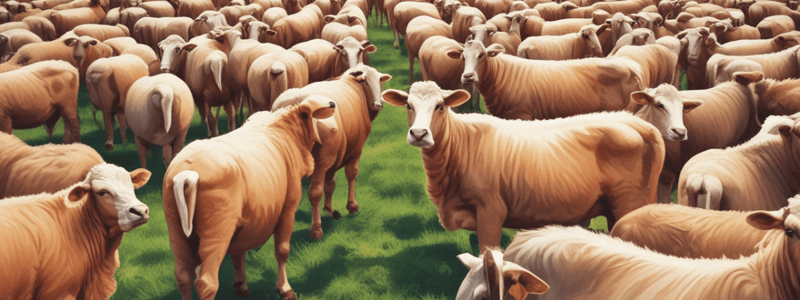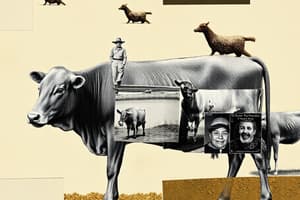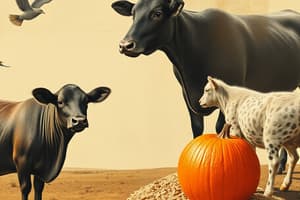Podcast
Questions and Answers
Why do ruminant animals have a different requirement of essential amino acids in their diet?
Why do ruminant animals have a different requirement of essential amino acids in their diet?
- Because they can produce their own essential amino acids
- Because they have a different type of digestive system
- Because they have a higher metabolism rate
- Because the fermentation process in the rumen provides these to the animal (correct)
What type of feeds are usually high in protein?
What type of feeds are usually high in protein?
- Grasses and hay
- Fruits and vegetables
- Cereals and grains
- Meals, which are by-products from other product manufacture (correct)
Why should high protein feeds not be provided to excess in a diet?
Why should high protein feeds not be provided to excess in a diet?
- Because they are not absorbed by the body
- Because they can cause digestive problems
- Because they are expensive (correct)
- Because they can lead to nutritional imbalances
What is the protein requirement of high producing animals compared to lower producing animals?
What is the protein requirement of high producing animals compared to lower producing animals?
What is the purpose of providing high protein feeds to animals?
What is the purpose of providing high protein feeds to animals?
What is the primary function of the rumen in ruminant animals?
What is the primary function of the rumen in ruminant animals?
What are the three main components of carbohydrates?
What are the three main components of carbohydrates?
Which of the following sugars is found in milk?
Which of the following sugars is found in milk?
What is the main source of energy for animals?
What is the main source of energy for animals?
Which of the following is an example of a complex sugar?
Which of the following is an example of a complex sugar?
What is the main function of the fermentation process in the rumen?
What is the main function of the fermentation process in the rumen?
What type of molecules make up lactose?
What type of molecules make up lactose?
What is the primary source of energy for animals?
What is the primary source of energy for animals?
What is the term for simple sugars?
What is the term for simple sugars?
What is a common source of carbohydrates for animals?
What is a common source of carbohydrates for animals?
What is the primary function of carbohydrates in an animal's diet?
What is the primary function of carbohydrates in an animal's diet?
Which type of sugar is composed of glucose and fructose molecules?
Which type of sugar is composed of glucose and fructose molecules?
What is the purpose of the fermentation process in the rumen of ruminant animals?
What is the purpose of the fermentation process in the rumen of ruminant animals?
What is the main difference between monosaccharides and saccharides?
What is the main difference between monosaccharides and saccharides?
Why are high protein feeds typically expensive?
Why are high protein feeds typically expensive?
What is a primary function of fats in the body?
What is a primary function of fats in the body?
What is a critical function of fats in brain development?
What is a critical function of fats in brain development?
What is a unique property of fats compared to protein and carbohydrates?
What is a unique property of fats compared to protein and carbohydrates?
What is a secondary function of fats in the body?
What is a secondary function of fats in the body?
What is a characteristic of essential fatty acids?
What is a characteristic of essential fatty acids?
What is a primary function of fats in the body?
What is a primary function of fats in the body?
What is a characteristic of essential fatty acids?
What is a characteristic of essential fatty acids?
What is the role of minerals in the body?
What is the role of minerals in the body?
What is a unique property of fats compared to protein and carbohydrates?
What is a unique property of fats compared to protein and carbohydrates?
What is the purpose of providing minerals in animal feed?
What is the purpose of providing minerals in animal feed?
What is the primary function of fats in the body?
What is the primary function of fats in the body?
What is the role of minerals in the animal body?
What is the role of minerals in the animal body?
What is unique about fats compared to protein and carbohydrates?
What is unique about fats compared to protein and carbohydrates?
What is the primary function of essential fatty acids?
What is the primary function of essential fatty acids?
What is the method of providing minerals to animals?
What is the method of providing minerals to animals?
What is the primary function of fats in the body?
What is the primary function of fats in the body?
What is unique about fats compared to protein and carbohydrates?
What is unique about fats compared to protein and carbohydrates?
What is a characteristic of essential fatty acids?
What is a characteristic of essential fatty acids?
What is the role of minerals in the body?
What is the role of minerals in the body?
How are minerals usually provided to animals?
How are minerals usually provided to animals?
What are vitamins classified as?
What are vitamins classified as?
What is the primary function of vitamins in the body?
What is the primary function of vitamins in the body?
What is the purpose of vitamin C in the body?
What is the purpose of vitamin C in the body?
What is vitamin D necessary for in Alpaca?
What is vitamin D necessary for in Alpaca?
What is the role of vitamins in maintaining good health?
What is the role of vitamins in maintaining good health?
What is the primary function of vitamins in the body?
What is the primary function of vitamins in the body?
What is the purpose of vitamin C in the body?
What is the purpose of vitamin C in the body?
What is vitamin D necessary for in Alpaca?
What is vitamin D necessary for in Alpaca?
What class of nutrients do vitamins belong to?
What class of nutrients do vitamins belong to?
What is a benefit of vitamins in the body?
What is a benefit of vitamins in the body?
What is the relationship between fibre content and digestibility in monogastric animals?
What is the relationship between fibre content and digestibility in monogastric animals?
Why does herbage vary in composition between and within plant materials?
Why does herbage vary in composition between and within plant materials?
What is the function of the caecum in monogastric animals?
What is the function of the caecum in monogastric animals?
What is the primary factor affecting digestibility in different feeds?
What is the primary factor affecting digestibility in different feeds?
Which type of animals have a specialized digestive system that allows them to break down high-fibre feeds?
Which type of animals have a specialized digestive system that allows them to break down high-fibre feeds?
Which of the following systems lacks a functional caecum?
Which of the following systems lacks a functional caecum?
What type of foods do monogastric animals have a poor ability to handle?
What type of foods do monogastric animals have a poor ability to handle?
What is the primary mechanism of digestion in monogastric animals?
What is the primary mechanism of digestion in monogastric animals?
Which of the following animals has a monogastric digestion system?
Which of the following animals has a monogastric digestion system?
What is the function of the appendix in monogastric animals?
What is the function of the appendix in monogastric animals?
What is the main difference between monogastric and hindgut fermentation digestion systems?
What is the main difference between monogastric and hindgut fermentation digestion systems?
What is the purpose of the caecum in monogastric digestion systems?
What is the purpose of the caecum in monogastric digestion systems?
What is a characteristic of animals with hindgut fermentation digestion systems?
What is a characteristic of animals with hindgut fermentation digestion systems?
Why do animals with hindgut fermentation digestion systems need to eat large quantities of food?
Why do animals with hindgut fermentation digestion systems need to eat large quantities of food?
What is the main difference in the digestive process between dogs and horses?
What is the main difference in the digestive process between dogs and horses?
Flashcards are hidden until you start studying
Study Notes
Ruminant Animals and Protein Requirements
- Ruminant animals, such as cattle, have a unique nutritional requirement due to their rumen fermentation process, which synthesizes essential amino acids.
- The rumen's fermentation process provides essential amino acids to the animal, reducing their dietary requirement.
High Protein Feeds
- High protein feeds are commonly referred to as 'meals' and often consist of by-products from other manufacturing processes.
- High protein feeds are generally expensive and should be provided in moderation to avoid excess in the diet.
Protein Needs and Production Level
- High-producing animals require a higher protein intake in their diet compared to lower-producing animals.
Ruminant Animals and Protein
- Ruminant animals, such as cattle, do not require essential amino acids in their diet due to the fermentation process in the rumen, which provides these nutrients.
- High protein feeds, known as "meals", are often by-products from the manufacture of other products.
- High protein feeds are typically expensive and should be provided in moderation to avoid excess.
Carbohydrates
- Carbohydrates are the main source of energy for animals.
- They are composed of carbon, hydrogen, and oxygen.
- Carbohydrates are primarily derived from plants.
- Common sources of carbohydrates include grains, wheat, oats, and barley.
Types of Carbohydrates
- Monosaccharides: simple sugars, including:
- Glucose
- Fructose (found in fruit)
- Galactose (found in milk)
- Saccharides: complex sugars, including:
- Table sugar (comprised of glucose and fructose molecules)
- Lactose (milk sugar, made up of glucose and galactose molecules)
Ruminant Animals and Protein
- Ruminant animals, such as cattle, do not require essential amino acids in their diet due to the fermentation process in the rumen, which provides these nutrients.
- High protein feeds, known as "meals", are often by-products from the manufacture of other products.
- High protein feeds are typically expensive and should be provided in moderation to avoid excess.
Carbohydrates
- Carbohydrates are the main source of energy for animals.
- They are composed of carbon, hydrogen, and oxygen.
- Carbohydrates are primarily derived from plants.
- Common sources of carbohydrates include grains, wheat, oats, and barley.
Types of Carbohydrates
- Monosaccharides: simple sugars, including:
- Glucose
- Fructose (found in fruit)
- Galactose (found in milk)
- Saccharides: complex sugars, including:
- Table sugar (comprised of glucose and fructose molecules)
- Lactose (milk sugar, made up of glucose and galactose molecules)
Ruminant Animals and Protein
- Ruminant animals, such as cattle, do not require essential amino acids in their diet due to the fermentation process in the rumen, which provides these nutrients.
- High protein feeds, known as "meals", are often by-products from the manufacture of other products.
- High protein feeds are typically expensive and should be provided in moderation to avoid excess.
Carbohydrates
- Carbohydrates are the main source of energy for animals.
- They are composed of carbon, hydrogen, and oxygen.
- Carbohydrates are primarily derived from plants.
- Common sources of carbohydrates include grains, wheat, oats, and barley.
Types of Carbohydrates
- Monosaccharides: simple sugars, including:
- Glucose
- Fructose (found in fruit)
- Galactose (found in milk)
- Saccharides: complex sugars, including:
- Table sugar (comprised of glucose and fructose molecules)
- Lactose (milk sugar, made up of glucose and galactose molecules)
Fats: Lipids and Energy Source
- Fats are a group of organic compounds known as lipids, found in both plants and animals.
- They provide and store energy in the long term, offering twice the energy of protein and carbohydrates.
- Fats serve as a cushion for vital organs, acting as a shock absorber.
- They are critical for building new cells and are essential for brain development and nerve function.
- Essential fatty acids are necessary for the production of some hormones and hormone-like substances.
Lipids (Fats)
- Group of organic compounds that provide and store energy long-term
- Found in plants and animals
- Provide twice the energy of protein and carbohydrates
- Cushion vital organs, acting as a shock absorber
- Essential for building new cells and critical for brain development and nerve function
Essential Fatty Acids
- Necessary for production of some hormones and hormone-like substances
Minerals
- Inorganic substances that provide structural support for the animal
- Essential for construction of bones (calcium and phosphorous), egg shells (calcium), muscles, blood cells, internal organs, and enzymes
- Often added to feed in their chemical form
- Can be fed free choice, such as with salt blocks
Lipids (Fats)
- Group of organic compounds that provide and store energy long-term
- Found in plants and animals
- Provide twice the energy of protein and carbohydrates
- Cushion vital organs, acting as a shock absorber
- Essential for building new cells and critical for brain development and nerve function
Essential Fatty Acids
- Necessary for production of some hormones and hormone-like substances
Minerals
- Inorganic substances that provide structural support for the animal
- Essential for construction of bones (calcium and phosphorous), egg shells (calcium), muscles, blood cells, internal organs, and enzymes
- Often added to feed in their chemical form
- Can be fed free choice, such as with salt blocks
Lipids (Fats)
- Group of organic compounds that provide and store energy long-term
- Found in plants and animals
- Provide twice the energy of protein and carbohydrates
- Cushion vital organs, acting as a shock absorber
- Essential for building new cells and critical for brain development and nerve function
Essential Fatty Acids
- Necessary for production of some hormones and hormone-like substances
Minerals
- Inorganic substances that provide structural support for the animal
- Essential for construction of bones (calcium and phosphorous), egg shells (calcium), muscles, blood cells, internal organs, and enzymes
- Often added to feed in their chemical form
- Can be fed free choice, such as with salt blocks
Vitamins and Micronutrients
- Vitamins are considered micronutrients, essential for normal body processes.
- Vitamins provide animals with the ability to fight stress and disease, and maintain good health.
- Vitamin C helps to ward off the flu.
- Vitamin D is necessary to prevent rickets, a bone degradation disease in Alpacas.
Vitamins and Micronutrients
- Vitamins are considered micronutrients, essential for normal body processes.
- Vitamins provide animals with the ability to fight stress and disease, and maintain good health.
- Vitamin C helps to ward off the flu.
- Vitamin D is necessary to prevent rickets, a bone degradation disease in Alpacas.
Digestibility of Feeds
- Digestibility is closely related to the chemical composition of feeds.
- High digestibility means that the nutrients are being extracted to be used by the body.
Factors Affecting Digestibility
- Grains show little variation in digestibility.
- Herbage (plant materials) varies in composition and digestibility depending on the growth stage.
Fibre Content and Digestibility
- Higher fibre content is associated with lower digestibility for monogastric animals.
Role of Caecum
- The caecum (appendix) plays a role in breaking down roughage.
Monogastric Digestion Systems
- Characterized by a non-functional caecum (appendix) that is unable to break down roughage
- Found in animals such as dogs, cats, rats, mice, pigs, and fish
- Digestion process involves chemical action on food material
- Have a poor ability to handle fibrous foods
Monogastric Digestion Systems
- Non-functional caecum (appendix) is present in dogs, cats, rats, mice, pigs, and fish.
- These animals have a poor ability to handle fibrous foods.
- Digestion involves chemical action on food material.
Functioning Caecum - Hind Gut Fermenter
- Horse, rabbit, and guinea pig have a functioning caecum and enlarged colon.
- The caecum and colon contain micro-organisms that break down fibrous plant material through microbial fermentation.
- Absorption is low in these animals, requiring them to eat large quantities of food to obtain required nutrients.
Studying That Suits You
Use AI to generate personalized quizzes and flashcards to suit your learning preferences.




